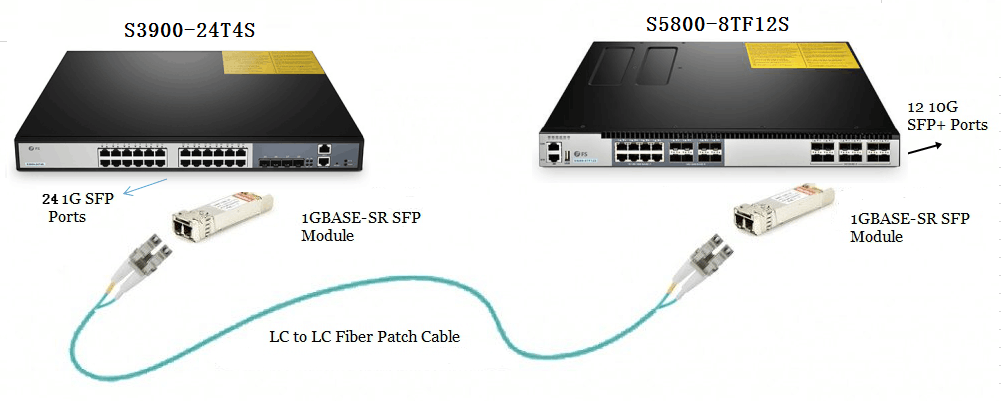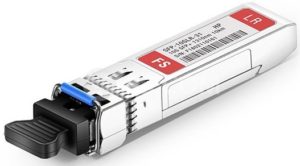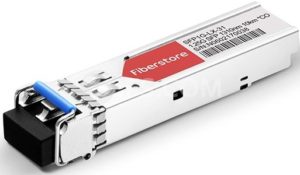With the tendency for higher speed network, 10Gb switch has already become familiar with home individuals, no longer the privilege of enterprise operators. However, the issue of SFP to SFP+ compatibility always puzzles many network switch users, even some engineers. Will 1Gb SFP transceivers work with 10Gb SFP+ ports on 10Gb switch? Or will 10Gb SFP+ run at 1Gb to link gigabit switch? And If 10Gb optics in a switch can auto-negotiate to 1Gb when the other end is 1Gb? All these related questions origin from the link between 10Gb SFP+ slots on 10Gb switch and 1Gb SFP ports on gigabit switch. Thus this article will reveal the mask of SFP to SFP+ compatibility from this point of view.
Will 1Gb SFP transceivers/modules work with 10Gb SFP+ ports? The answer is “Yes” in most cases. There are many vendors providing 10Gb switches that can take both a 10G SFP+ and a 1G SFP in the 10Gb SFP+ slot, but not at the same time for obvious reasons. This option is supported by dual speed operation. So before plugging a SFP transceiver into the SFP+ port on your 10GbE switch, one must consult your rep to make sure the 10Gb switch port support dual speed.
To achieve link of 10Gb switch port to gigabit switch port, here is a simple guide. Install a 1Gb SFP module on the 10GbE switch SFP+ port and the gigabit switch 1Gb SFP port respectively, then connect the 10Gb switch and the gigabit switch with corresponding 1Gb SFP fiber cable or Ethernet copper cable (eg. Cat6).
Will 10Gb SFP+ running at 1Gb? The answer is definitely “No”. SFP optics do work in SFP+ slots in most cases, but SFP+ optics on 10Gb switch can never work in SFP slots on gigabit switch. The reason is about a power availability thing. As we know, once an module is installed, the speed of the port is decided. Most SFP+ slots are backward compatible with SFP modules to run at 1G speed. However, the SFP slots on gigabit switch cannot support the 10G speed required by SFP+ modules. For instance, most Cisco and FS 10Gb switches support 10G SFP+ and 1G SFP optics on their SFP+ ports. But some Brocade gear and HP A-series models are SFP+ only. One need to double check the compatibility of this switch with the vendor rep.
FS 10Gb switch SFP+ port links to gigabit switch SFP port via 1G SFP modules and fiber patch cable.
Unlike copper SFP modules supporting 10/100/1000 auto-sensing, fiber optics do not support auto-negotiation. Because this technology is based on electrical pluses but not optical pluses. Thus 10Gb SFP+ optics on 10Gb switch can not auto-negotiate down to 1Gb if the other end is gigabit switch. In fact, most SFP and SFP+ transceivers only run at its rated speed and the transceivers at both end of the cable should at the same speed. For example, if a 10Gb SFP+ module is plugged into the 10Gb switch port, it will only run at 10Gb. In this case if you link it to the gigabit switch port, it will not work. When sticking a 1Gb SFP module in the 10G SFP+ port, the 10Gb switch will only run at 1Gb. As thus you can link it to gigabit switch.
Sometimes the 10GbE switch port would lock the speed at 1G until you reconfigure the switch to 10G. It is noted that SFP+ port usually enables a speed under 1G, which means one cannot insert 100Base SFP modules into SFP+ ports on 10Gb switch.
For the issue of SFP to SFP+ compatibility, a simple response is that most SFP+ can take SFP but not vice versa. The uncertain situation requires one to ask their switch vendors for clear reply. Thus 10Gb switch port is possible to link to gigabit switch port to run at 1G speed. The only thing you need to do is to plug each the aforesaid port with a 1Gb SFP module, and then connect the two modules on the 10Gb switch and the gigabit switch with a corresponding fiber patch cable or Ethernet copper cable.



